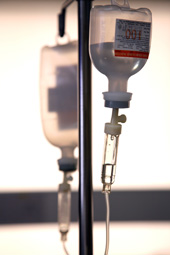Project Success Stories - Nano-drugs home in on cancer
Photodynamic therapy provides an effective treatment for many cancers by using a combination of photosensitiser, red light and oxygen found in cancer cells and tissue. The photosensitiser is a chemical that can be excited by light. Once excited, it will react with oxygen and in this state it causes cell death in the tumour where the photosensitiser accumulates. While PDT is an effective treatment, it could be improved. Currently the dose of photosensitising drugs affects patients' healthy tissue as well as their tumours. Doctors have to use a high dose of drug to obtain good tumour control, which makes the treatment more expensive. Using a high dose also leads to greater side effects, more complications and longer hospital stays. Enter the EU-funded Nanophoto project, an initiative to develop targeted nano-systems for improving photodynamic therapy and diagnosis of cancer. The team behind the research is creating a nano-particle drug delivery system that behaves like a tiny, cancer-seeking homing missile, attaching itself to the tumour and then delivering the drug payload. 'The major achievement should be the development of a biocompatible nano-system decorated on its surface with an agent, such as particular ligands or antibodies, capable of recognising cancer cells in a selective manner,' explains Dr Elena Reddi, coordinator of the Nanophoto project. Once the drug attaches to the targeted cancer cell, PDT continues as normal. Photo-stimulation activates the drugs that attack the cancer. Since drug delivery is more targeted, it uses a much smaller dose. This makes it cheaper, both because it uses fewer drugs, but there are also fewer side effects and patients do not need to stay in hospital as long. It is promising, but there are challenges, too, most notably in the biocompatibility of the nano-particles, and the risk that the bloodstream's immune system will attack the particles before they can reach their target. So the Nanophoto project developed a highly focused research plan to characterise and test three promising nano-particle candidates, namely liposomes, organically modified silica (Ormosil) and poly(lactide-co-glycoloide)co-polymer or PLGA. In the Nanophoto project, these potential delivery systems carry mTHPC, or meta-tetrahydroxyphenyl chlorine, marketed under the names Foscan and Temoporfin. This drug is a photosensitiser that Nanophoto chose to validate the concept. The final system will be able to adapt to a wide range of therapeutic and diagnostic drugs. The concept is ingenious and could open the way for targeted delivery of a wide range of drugs to treat a large number of conditions. It is also a tough technical challenge. Progress so far, however, is very good. In the first half of a three-year project the Nanophoto team has racked up considerable success. 'We have already identified some nano-carriers that produce at least three-fold increase of drug accumulation in the tumour in comparison to the standard formulation currently used in clinical PDT,' notes Dr Reddi. Stealth particles This made the subsequent PDT treatment dramatically more effective, particularly because pharmacokinetic or active properties of mTHPC improve significantly when it is delivered by nano-carriers. Essentially, the drug punches above its weight when it is delivered using the Nanophoto system. Moreover, Dr Reddi reveals that the results promise significant potential in reducing adverse side effects such as skin photosensitivity in patients treated with PDT. Stability is an essential element of drug nano-particles used intravenously because prolonged circulation in the bloodstream is essential to ensure tumours are sufficiently dosed with the required drug. To this end, Nanophoto worked on the development of so-called 'PEGylated' nano-particles, which Dr Reddi stresses is the most important breakthrough of the project so far. This simply means coating the carriers with polyethylene glycol (PEG), a phenomenally useful chemical formulation whose primary novelty is that it remains undetected by the immune system. This let Nanophoto create stealth particles. 'PEGylated nano-carriers with stealth properties that can be used for a new formulation of mTHPC will bring a substantial improvement to clinical PDT treatment,' suggests Dr Reddi. Indeed, the team noted a direct correlation between the density of PEG chains on the nano-particle surface and its success at evading immune response. The research also threw up unexpected challenges along the way. There was some leakage from the nano-particles when they were exposed to blood serum, particularly Ormosil. To prevent leakage, the team bound the mTHPC with the nano-particle using covalent molecular bonding. The drug retained its ability to excite oxygen in cancer cells. In the first 18 months the consortium demonstrated that the three nano-particles can deliver the drug, PEGylation improves biocompatibility and that tumours take up three times more drug than with the standard delivery. Put another way, clinicians could reduce drug doses by two thirds and still see the same therapeutic benefits of PDT. Nanophoto is a translation research project, meaning it is intended to move research from the lab to the real world, from the Petri dish to the patient. Nanophoto brings together scientists and clinicians from a large range of disciplines and commercial partners to undertake work ranging form synthetic and cellular assays though to preclinical animal testing. The project has scored a number of achievements in a short time. Already the consortium of five partners has produced dozens of journal and conference papers, and it will continue its work until the middle of 2011, allowing the team to tackle remaining challenges. 'Now we are facing the tremendous challenge of imparting to these nano-systems the capacity to deliver the drug even more specifically to cancer tissues by exploiting active mechanism of targeting. This is being achieved by decorating the nano-carriers with molecules able to seek cancer cells, bind to them and place the drug cargo inside them,' notes the project coordinator. Nanophoto project received funding from the Health programme of the Seventh Framework Programme (FP7) for research.



